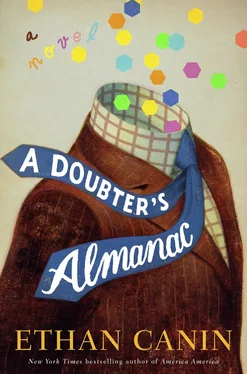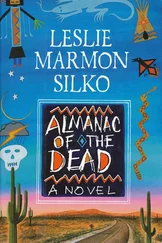Otherwise, nothing: not even a business card. Just an old rubber band around a poorly glued binding. On the cover, a single title had been circled in the same heavy pencil: a paper by Benedek Fodor, a mathematician I’d revered in graduate school. But the paper had nothing to do with Shores-Durban equilibria — in fact, when I glanced at it, I saw that it had nothing to do with my work at all — so I didn’t read it. And I’d never even heard of the journal.
I was busy in those days.
If I’d already known of Earl Biettermann, of course, I would have read the article with great care; but Dad hadn’t yet told me any of those stories. In fact, if it weren’t for the esteem in which Fodor was held by just about everyone in my field, I would probably have just thrown away the whole thing.
But something must have stopped me: it might have been the rubber band. I’m no topologist, but I still have my feelings about stretchable curves. This one, drawn tight where it doubled around the binding, was beginning to crumble. Along one edge, as all such shortened annuli must minimally be, it had been twisted exactly twice. Whoever had sent it had taken care to minimize the twists and to migrate them to a single segment.
That was interesting.
But all kinds of my quant colleagues were in the habit of sending me all kinds of interesting quant things, and I usually had no time to even glance at them. I remember pulling the stretchy little noose off the binding and playing with it a little in my fingers. I might have even thought for a second about giving the article another look, but it was at that moment that my Southern Hemisphere terminals began chiming — the three rising low-pitched bongs that signal the opening of the São Paulo exchange — so I dropped the journal on a shelf, brushed off my desk, and sat back down to work.
—
BY THE END of that year, the rubble from the Trade Center had been cleared and most of our competitors had high-tailed it for either Connecticut or New Jersey, where they were running their tired old algorithms out of glass-and-brick low-rises with lawns around the parking lots. But not Physico. Over at 40 Wall Street, where I’d been employed since the morning they’d airlifted me out of graduate school, we’d kept our noses tight against the grindstone. For people like us, those were the halcyon days. The private equity markets on the West Coast had already made and lost their billions. The Dow had recovered. Bin Laden was on the run. The weak hands had folded, and now, apparently, we were all moving on.
The quants in particular were surfing a wave. At Physico, I was developing a strategy to capitalize on a certain species of put/call mismatch that existed fleetingly across a whole host of currency platforms worldwide. Didn’t matter if those markets were headed up or down, of course. That was the point.
In those days — at the beginning of those days, anyway — I was about the only one doing it.
Two years before, on a Physico jet, I’d landed at Teterboro Airport, carrying a taped-up box of mathematics books and two fraying duffel bags, one of which contained the first third of my dissertation on Shores-Durban equations. By the end of the day, I was sitting in my own private office on the top floor of the Trump Building. From my window I could look west, back toward Columbus, and watch the weather roll in. There were no other traders on my floor, mostly because any red-blooded trader would have served me up on a skewer if he’d discovered how old I was, not to mention what I was about to do to his livelihood. The strategy I was developing was fundamentally conservative — every bet I made was soundly hedged — but it stood to put more than a few Wall Street types back in school.
It was not so conservative, I should add, that my employer wasn’t making a potful of money on me pretty much right out of the gate. I happened to be the first one down the well with my particular drill. We bought and sold the prediction of just about anything, as fast as the hardware could do it. One of my early gambits was the spread between the futures that were traded in Chicago and the securities they predicted in New York City. I used the fastest computers in the world over a network of fiber optics that gave Physico Partners, over the 790 miles between my west-facing window and the LaSalle Street exchange, a microsecond execution advantage against just about any other house, large or small, on the whole Eastern Seaboard. As we quants liked to say ourselves: money in the bank.
From my first morning in a suit, I was placing well long of a hundred thousand orders in an hour. On my job interview, as a sixteen-year-old doctoral candidate in a scarlet-and-gray windbreaker and Birkenstocks, I’d been flattered into showing a group of men in Ferragamo loafers how Shores-Durban equations could forecast the swell and shrink of just about every type of large-market inefficiency that existed anywhere — inefficiencies that until that point had been dismissed as noise. I could tell that nobody in the room, not even the other stat-arb quants, understood exactly what I was talking about. Nonetheless, Physico took less than an hour to offer me a signing bonus that well exceeded the salary my father had earned over his entire career. I waited a few days to accept; but when I did, a limousine was dispatched to the front door of the OSU mathematics department.
Take that, Seth Kopter.
Two years into it, though, my system still wasn’t perfect. I was still programming every night after the close, still triangulating my executions until they asymptotically approached the optimums for my newly hatched breed of computational microstructure trades, which, to put it boastfully (but accurately), swarmed like piranha around the clumsy, staggering hooves of our rivals. And I have to say, I was liking it. At any hour of the day or night, I was capable of laserlike concentration, knifelike thought, and hoglike greed. Occasionally, well into morning, my mind might crystallize into something more pure: I would glance at the stapled-together dissertation notes on my shelf and imagine Isaac Newton during the plague years, leaning over a table in Woolsthorpe-by-Colsterworth, deriving his fluxional calculus. But that didn’t stop me. My Sharpe ratio was scoffing at the bulge bracket from the top of a very tall building. I could locate a microinefficiency anywhere in the world — Chicago, Hong Kong, you name it — and without even bothering with the indignity of leverage could turn a remarkably reliable profit in the nanosecond it took a cesium 133 atom to oscillate a bare handful of times between energy states. It was all fun and games.
In fact, I probably would have done it for nothing.
What really drove me was the thing I knew instinctively, every single day that I was swept up in that silent elevator to the seventieth floor of the Trump Building: that an even-more-accurate algorithm lay out there somewhere. I knew it in the way my father had once known, staring at the flats of San Francisco Bay, that he stood at the edge of absolutely the correct abyss. I would place my million trades a day, then sit at my glass-topped desk well into morning, doing and redoing every move in my mind.
Ah, recidivism. It’s the fly in the ointment.
The only obvious problem with my life — that is, the only one I was worried about at the time — was that to a numerically inclined mind like my own, the economics of normal existence were becoming untenable. How could I go for a half-hour walk in Battery Park when it meant $25,000 in income? Was a coffee at Starbucks worth the price of a Mercedes?
I’d been raised on mathematics. Now I was starting to doubt a few of its dictates.
At some ungodly hour of the night, I would at last allow myself to quit. The empty elevator whisked me back down to the lobby, where Lorenzo, my Astoria-Italian driver, would be idling at the Pine Street entrance in his Town Car, waiting to take me home to the brownstone, which was on Perry Street near the river.
Читать дальше












